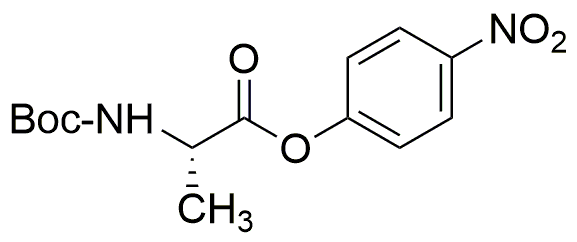Boc-L-alanine-4-nitrophenyl ester is widely utilized in research focused on
- Peptide Synthesis: This compound serves as a valuable building block in the synthesis of peptides, enabling researchers to create complex structures for various applications in drug development.
- Drug Design: Its unique properties allow for the modification of drug candidates, enhancing their efficacy and bioavailability, particularly in the pharmaceutical industry.
- Bioconjugation: The compound can be used in bioconjugation techniques, facilitating the attachment of biomolecules to surfaces or other molecules, which is crucial in developing targeted therapies.
- Research in Enzyme Inhibition: It is employed in studies aimed at understanding enzyme mechanisms, providing insights that can lead to the development of new inhibitors for therapeutic purposes.
- Analytical Chemistry: The ester can be utilized in analytical methods to quantify amino acids and peptides, aiding researchers in quality control and formulation development.
General Information
Properties
Safety and Regulations
Applications
Boc-L-alanine-4-nitrophenyl ester is widely utilized in research focused on
- Peptide Synthesis: This compound serves as a valuable building block in the synthesis of peptides, enabling researchers to create complex structures for various applications in drug development.
- Drug Design: Its unique properties allow for the modification of drug candidates, enhancing their efficacy and bioavailability, particularly in the pharmaceutical industry.
- Bioconjugation: The compound can be used in bioconjugation techniques, facilitating the attachment of biomolecules to surfaces or other molecules, which is crucial in developing targeted therapies.
- Research in Enzyme Inhibition: It is employed in studies aimed at understanding enzyme mechanisms, providing insights that can lead to the development of new inhibitors for therapeutic purposes.
- Analytical Chemistry: The ester can be utilized in analytical methods to quantify amino acids and peptides, aiding researchers in quality control and formulation development.
Documents
Safety Data Sheets (SDS)
The SDS provides comprehensive safety information on handling, storage, and disposal of the product.
Product Specification (PS)
The PS provides a comprehensive breakdown of the product’s properties, including chemical composition, physical state, purity, and storage requirements. It also details acceptable quality ranges and the product's intended applications.
Certificates of Analysis (COA)
Search for Certificates of Analysis (COA) by entering the products Lot Number. Lot and Batch Numbers can be found on a product’s label following the words ‘Lot’ or ‘Batch’.
Numéro de catalogue
Numéro de lot/série
Certificates Of Origin (COO)
This COO confirms the country where the product was manufactured, and also details the materials and components used in it and whether it is derived from natural, synthetic, or other specific sources. This certificate may be required for customs, trade, and regulatory compliance.
Numéro de catalogue
Numéro de lot/série
Safety Data Sheets (SDS)
The SDS provides comprehensive safety information on handling, storage, and disposal of the product.
DownloadProduct Specification (PS)
The PS provides a comprehensive breakdown of the product’s properties, including chemical composition, physical state, purity, and storage requirements. It also details acceptable quality ranges and the product's intended applications.
DownloadCertificates of Analysis (COA)
Search for Certificates of Analysis (COA) by entering the products Lot Number. Lot and Batch Numbers can be found on a product’s label following the words ‘Lot’ or ‘Batch’.
Numéro de catalogue
Numéro de lot/série
Certificates Of Origin (COO)
This COO confirms the country where the product was manufactured, and also details the materials and components used in it and whether it is derived from natural, synthetic, or other specific sources. This certificate may be required for customs, trade, and regulatory compliance.

